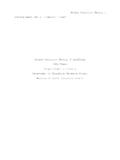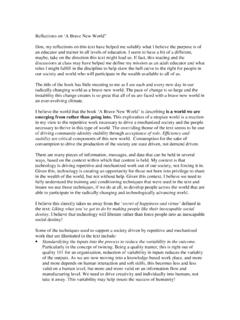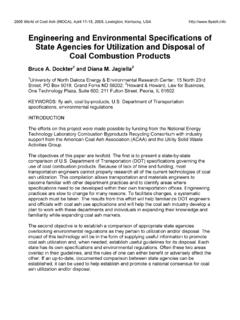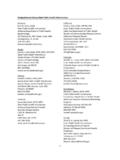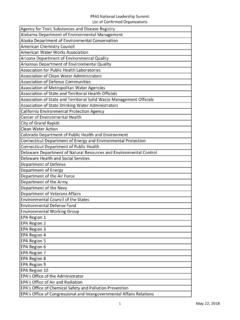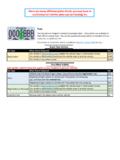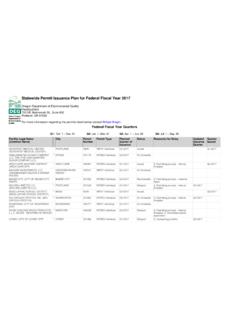Transcription of Social Cognitive Theory, basic concepts and …
1 Social Cognitive theory 1 Running head: Social Cognitive THEORYS ocial Cognitive theory , basic concepts and understandingJohn InmanOregon State UniversityDepartment of Education Graduate SchoolMasters in Adult Education CohortSocial Cognitive theory 2 Social Cognitive theory , basic concepts and understandingSocial Cognitive TheoryF. Pajares (1996) In Social Foundations of Thought andAction, Albert Bandura (1986) wrote that individuals possess aself-system that enables them to exercise a measure of controlover their thoughts, feelings, and actions. This self-systemhouses one's Cognitive and affective structures and includes theabilities to symbolize, learn from others, plan alternativestrategies, regulate one's own behavior, and engage in self-reflection.
2 It also plays a prominent role in providingreference mechanisms and a set of sub functions for perceiving,regulating, and evaluating behavior, which results from theinterplay between the self-system and external environmentalsources of influence. As such, the self-system serves a self-regulatory function by providing individuals with the capabilityto alter their environments and influence their own felt that the behavioral models did not adequatelyexplain how adults learned and that important psychologicalprocesses had been overlooked or only partially studied. Themost notable finding that prompted his work was that peoplecould learn new actions merely by observing others perform themand this did not fit into the behavioral model of learning.
3 Theenactive model that promoted leaning by performing tasks andkeeping or discarding the learning based on whether the task wassuccessful was far too limiting, particularly in complex workwhere to simply do the task to learn it is virtually Cognitive theory 3 Albert Bandura (1977, p. 22) states , "Learning would beexceedingly laborious, not to mention hazardous, if people hadto rely solely on the effects of their own actions to informthem what to do. Fortunately, most human behavior is learnedobservationally through modeling; from observing others oneforms an idea of how new behaviors are performed, and on lateroccasions this coded information serves as a guide for people can learn from example what to do, at least inapproximate form, before performing any behavior, they arespared needless errors.
4 "Of important note to the discussion of Social CognitiveTheory is the concept of latent action based on observation. Alearner may very well not use what is observed for weeks,months, or indeed years. Enactive learning or practice will helpsolidify the learning from vicarious observational and or AuthorsTheorists primarily include Bandura and Zimmerman withothers to include but not limited to Rosethal, Berger, Cognition Key Learning ConceptsThe foundation of Bandura's Social Cognitive theory isreciprocal interactions. The major break from behavioraltheorists came with Bandura's model of triadic reciprocility. Inthis model, Bandura postulated that the person, the behavior,and the environment were all inseparably entwined to createleaning in an individual.
5 The next quote by Bandura states thisquite Cognitive theory 4 Albert Bandura (1986, p. 18) In the Social Cognitive viewpeople are neither driven by inner forces nor automaticallyshaped and controlled by external stimuli. Rather, humanfunctioning is explained in terns of a model of triadicreciprocility in which behavior, Cognitive and other personalfactors, and environmental events all operate as interactingdeterminants of each (2000) According to Social Cognitive Theory, observing a model does not guarantee learning or later abilityto perform the behaviors. Rather, models serve informational andmotivational functions by providing information about probableconsequences of actions and affecting observers' motivation toact accordingly.
6 Factors influencing learning and performanceare developmental status of learners, prestige and competence ofmodels, vicarious consequences to models, goals, outcomeexpectations, and perceived (2000, p. 108) Self-efficacy refers to personalbeliefs about one's capabilities to learn or perform actions atdesignated levels. Albert Bandura (1997) Self-efficacy is abelief about what one is capable of doing; it is not the same asknowing what to do. In gauging efficacy, individuals assesstheir skills and their capabilities to translate those skillsinto understandingIn Pajares (1996), the description by the author ofBandura's understanding of Social Cognitive theory and itscomponents is as clear as I can be on what he may understand ofSocial Cognitive theory 5this body of work.
7 "How individuals interpret the results oftheir performance attainments informs and alters theirenvironments and their self-beliefs, which in turn inform andalter their subsequent performances. This is the foundation ofAlbert Bandura's (1978 & 1986) conception of reciprocaldeterminism, the view that (a) personal factors in the form ofcognition, affect, and biological events, (b) behavior, and (c)environmental influences create interactions that result in atriadic reciprocality. Because personal agency is sociallyrooted and operates within sociocultural influences, individualsare viewed both as products and as producers of their ownenvironments and of their Social Bandura (1986) considered self-reflection the mostuniquely human capability, for through this form of self-referent thought people evaluate and alter their own thinkingand behavior.
8 These self-evaluations include perceptions ofself-efficacy, that is, "beliefs in one's capabilities toorganize and execute the courses of action required to manageprospective situations" (Albert Bandura 1997, p. 2). Thesebeliefs of personal competence affect behavior in several influence the choices individuals make and the courses ofactions they pursue. Efficacy beliefs help determine how mucheffort people will expend on an activity, how long they willpersevere when confronting obstacles, and how resilient theywill prove in the face of adverse situations-the higher thesense of efficacy, the greater the effort, persistence, Cognitive theory 6 ReferencesBandura, Albert (1977).
9 Social Learning theory . EnglewoodCliffs, : , Albert (1978). The self-system in reciprocaldeterminism. American Psychologist, 33, , Albert (1986). Social Foundations of Thought andAction: A Social Cognitive theory . Englewood Cliffs, :Prentice , Albert (1997). Self-efficacy: The exercise ofcontrol. New York: , F. (1996). Self-efficacy beliefs in academicsettings. Review of Educational Research, 66(4), February 7, 2001 from the World Wide Web: ~whuitt/psy702/ , Dale H. (2000). Social Cognitive theory . In KevinM. Davis (Ed.), Learning theories: an educational perspective(3rd ed., p. 118). Upper Saddle River, New Jersey: MERRILL, anImprint of Prentice-Hall.
